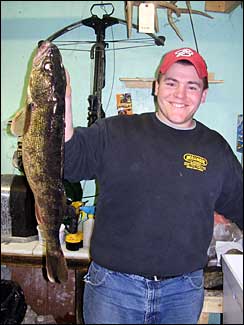You Can Find Walleye In New Hampshire

In past years, most of my walleye fishing occurred in Lake Erie and Lake Ontario. They were trips that came away with fishing excitement and a catch of excellent size walleyes, in the 6 to 10 pound class, that made for very tasty meals. My late father-in-law, Gus Marinier, and I found that their fried filets tasted much like haddock, a well enjoyed ocean fish.
Common names for walleye are walleyed pike and pike perch. Walleye have a long cylindrical body, elongate conical head with a large mouth containing large, sharp canine teeth, a reason they must be handled very carefully when caught. They have conspicuous milky eyes and two well separated dorsal fins, one spinous and one soft-rayed. Their coloration is variable, but normally dark olive-brown, densely mottled with fine brassy flecks, while the under parts are pinkish-white. There is a conspicuous black blotch on the extreme rear portion of the spineous dorsal fin. The first dorsal fin contains 12 to 16 spines, while the second has one spine followed by 17 to 22 soft rays. There are two weak spines followed by 11 to 14 soft rays in the anal fin.

Chris Lord of Claremont NH caught this
walleye of
6 lbs., 26" in the Connecticut River in April of
2009.
Walleye live in both lakes and rivers. They thrive best in clear waters and prefer areas with a firm bottom, such as gravel or bedrock. They do not do well in weedy waters. Walleye are basically nocturnal fish. They move on to bars or rocky shoals at night to feed. Because of their sensitivity to light, they remain in deeper waters during the day time. They also may inhabit water of considerable depth in late summer when surface temperatures are at their highest degrees.
Young walleye feed on plankton and insect larva for most of their first year. Following this stage, the young shift to a diet of small fish. Adults feed mainly on shiners, shad minnows and rainbow smelt. When these species are not available, they will feed on almost any suitable sized prey.
The usual size of this largest member of the perch family is one to five pounds. However, fish up to 10 pounds are not unusual. The New Hampshire State record walleye was caught in the Connecticut River on April 4, 1992 by Anthony
Bartolini. His walleye was 34 inches long and weighed 12 lbs. 8.8
ozs. The world record walleye was caught in Tennessee in 1960. It weighed 25 pounds and was 41 inches long.
In New Hampshire, walleyes are found only in selected water bodies, such as the Connecticut and Merrimack Rivers. They can be caught by still-fishing with live minnows or by trolling or casting any artificial lure, spoon, spinner or a minnow-spinner combination. It is somewhat a difficult fish to catch and when hooked it is not the spectacular fighter one might expect for its size. The most productive fishing is generally in the evening or early morning.
The walleye is highly prized by anglers throughout its range. In the Great Lakes region, it is a valuable commercial and sport fishing species. The white, firm, flakey and bone-free meat is definitely some of the best eating of all freshwater fishes. It is a fish that is truly a joy to catch and on the table for dinner.

Bob Harris can be
reached via e-mail at:
outwriter2@aol.com
Past
Columns by Bob Harris
>>>
About
Bob Harris
>>>
DISCLAIMER: The opinions
expressed by Mr. Harris are not necessarily those of the
Goffstown Residents Association or its members
Copyrightę2009 Goffstown Residents Association. All Rights Reserved. |





